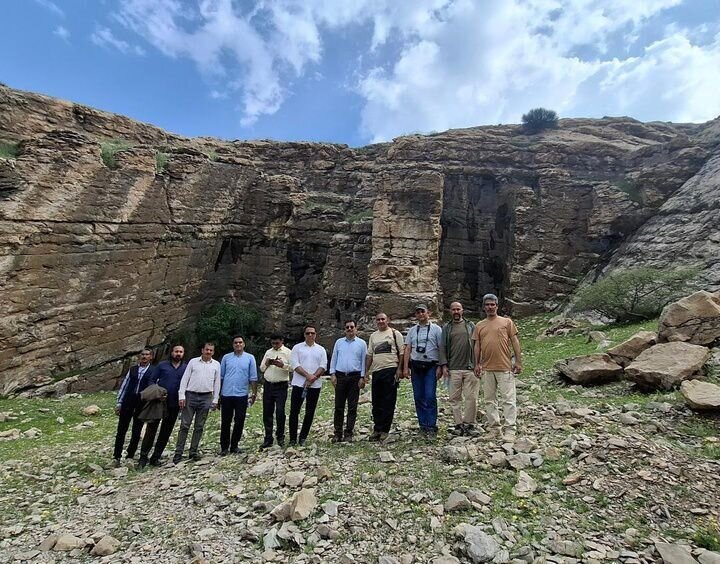Tehran – In a groundbreaking archaeological breakthrough, Iranian researchers have discovered what is believed to be a long-lost quarry used to source giant stones from Achemenidian period masterpieces, such as the palace of the Darius Palace in the ancient city of Sousa.
The site was discovered near the city of Abdanan in Ilam province in western Iran and has been hailed as one of the most important archaeological discoveries in Western Asia in recent years.
Mohammad Vahim Zaray, head of the Institute of Cultural Heritage Research in Iran, announced the discoveries during his official visit to Abdanan on Friday. “The origins of the stones used in Darius’ palace for over two thousand years remained a mystery. The discovery is incredible and can solve a historic puzzle from two thousand years ago,” he said.
The monumental discovery was made possible by the efforts of Mohammad Heidali, the local teacher who first proposed the site, and Luqman Ahmadzadeh-Shohani, an archaeologist who led the excavation project. The research team, working under the Institute’s Archaeology department, combined field research, satellite imagery and geological research, identified extensive remains of ancient quarrying operations. Among the findings are stone tools, evidence of extraction, and a large amount of limestone and iron ore, which may have been used to create metal joints in Acemenido stone.
The historical reference to the site named “Abiradush” mentioned in the inscription by Darius I as the source of the stones in the Palace of Appadana has long been intrigued. Until now, its exact location remained unknown. The newly identified quarry in the Kabir Ku Mountains near Abdanan is consistent with the description and is considered to be the legendary Abiradush.
“The Apadana Palace in Susa is one of the most majestic royal structures of ancient Iran. Identifying the true origins of building materials opens a new chapter in understanding the construction logistics, architectural planning and resource management of the Akemen family,” says Zarei.
The research team estimates the distance from the quarry to Susa at approximately 150 km. The stones may have been transported via complex routes combining mountain roads and riversides, particularly the Calfe River.
Archaeologists hope that the discovery will not only provide a deeper understanding of the engineering and architectural achievements of the Achaemenid Empire, but also lead to the potential nomination of the site for its UNESCO World Heritage Site status. This discovery could stimulate new avenues of cultural tourism and sustainable heritage development in the Central Zagros region.
Detailed research is ongoing and is expected to be published with more visual documents, but Zarei added that the findings are already comparing them to the famous Penteric marble quarry used to build the Parthenon in Athens.
This is not the first Achaemenid quarry identified in Iran. About a decade ago, archaeologists discovered large-scale stone extraction sites near Pasargadae, including the extensive “Almasborgh” quarry used to construct the foundations and decorative elements of royal structures.
Experts believe that ongoing research into these ancient quarrying systems will further illuminate the sophisticated techniques employed by Achaemenid builders, from extracting 2-50 tonnes of stone blocks to transport by acid-drawing carts and final polishing using dated palm fibers and sharkskins.
Susa, gateway to a must-see destination
Registered by UNESCO, Susa was once the winter residence of the Persian king after being captured by Cyrus the Great. Susa became part of the Persian Empire under the great Cyrus II in 538 or 539 BC.
Various archaeological seasons in Susa produced ample relics, including pottery, arms, ornaments, metalwork, bronze articles, and clay locks. Susa is also the entrance to several valuable destinations, including the UNESCO touched Zigrat in Choga Zanville, ruins of Achemeemenid Apadana Castle, the Crunch Castle (Acropole), the Temple of the Prophet Danaria, the Sousa Museum, and the archaeological mount of Hafts Tape.
Located at the lower part of the Zagros Mountains, Susa is identified as Shushan in Esther’s books and other biblical books.
To the left of the entrance ramp, pass a self-guided sign and past your palm to the excavation site at Darius Palace, 521 BC.
To the east is the royal family. This is a deep excavation site that runs through 15 levels. To the south of the castle is an eroded dirt guard tower overlooking a teenager riding a dirt bike.
Dominates the landscape on the right is the fortress-like Chateau de Morgan (Château de Morgan) built by the French on the bones of the Ellamite Acropolis to protect them from tribes plundered by the French in the early 20th century. It is not open to the public, but there are fantastic views from the road around the base, including views of Daniel’s grave from the south.
In the Bible, Susa is known primarily from the story of Esther. Esther had planned for the Agagaitians to defeat the Persian Jews. According to the story, Esther outweighs him by obstructing Haman’s plans for obstructing her husband, King Ahasueros of Persia. This episode is commemorated annually at Jewish Prim Festival, marked with costumed parties and other celebrations, following ancient origins.
It is said that Alexander of Macedonia captured Susa in 330 BC, plundered the city, and seized about 40,000 gold and silver talents from the Ministry of Finance. Alexander began the decline of Shushan by supporting Babylon, and soon after the rebellion the city was burned to the ground. It was later rebuilt by Sapor II (309-379 CE) and renamed Iranshahr Shapur, which later helped to resist the Arab invasion in 645.
After the collapse of the Achemenid Empire and the reign of Alexander the Great, who married in Susa, the city became part of the Seleucian Empire. He was now called the Celeus of Euraeus. A Greek palace was built next to Darius’ palace. However, the admin centre is located in the southern part of the city, where almost all Greek and Parthian inscriptions were discovered. During the Parthian era, cities created coins.
morning

